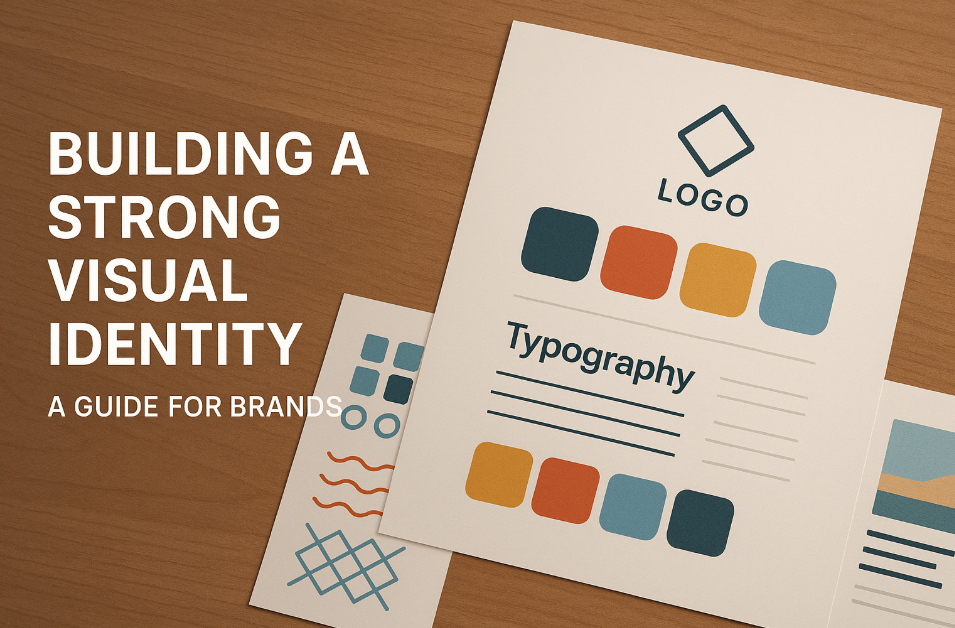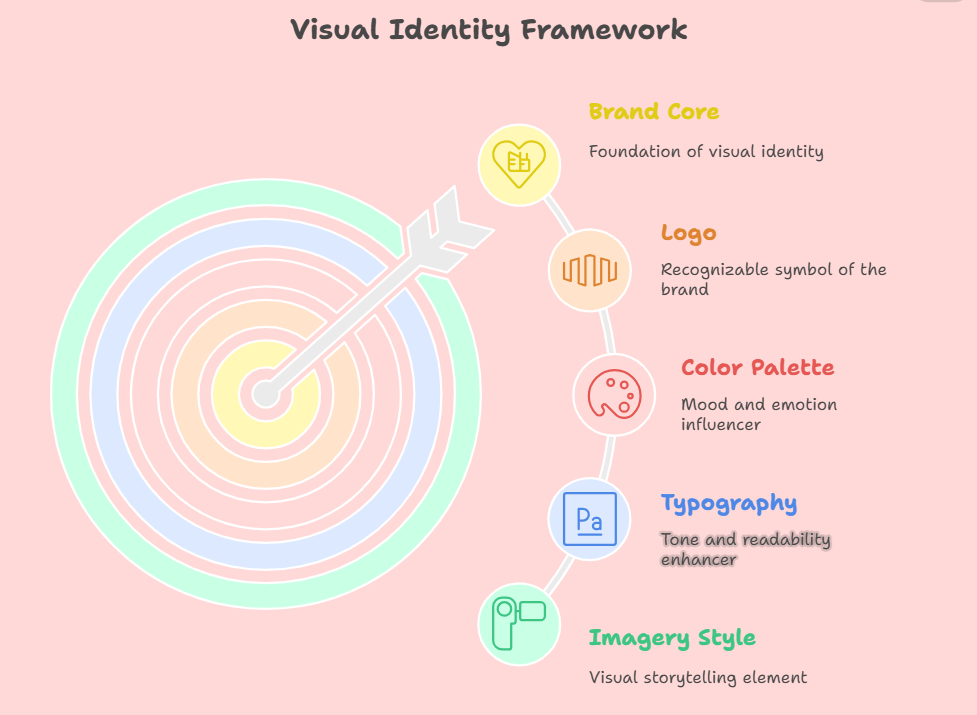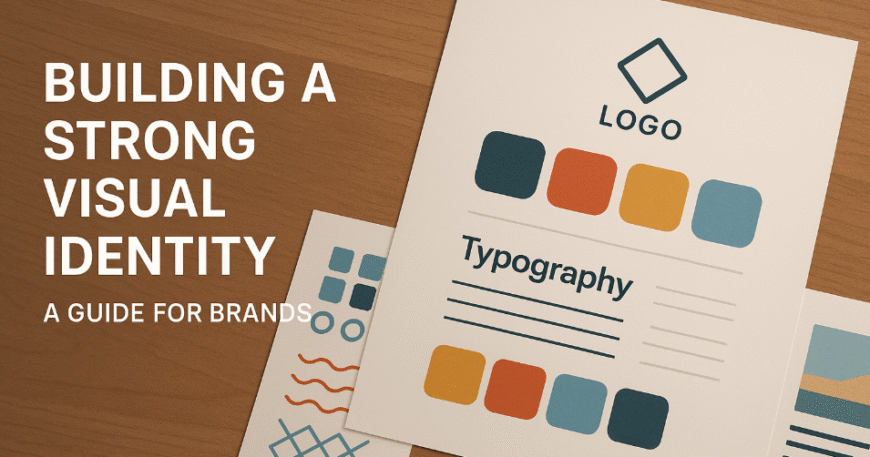Table of Contents
- Introduction
- What Is Visual Identity?
- Why Visual Identity Matters
- Core Elements of a Visual Identity
- Steps to Build a Strong Visual Identity
- Common Mistakes to Avoid
- Evolving and Maintaining Brand Identity
- Conclusion
- FAQs

Introduction
In the business world, first impressions matter—a lot. And your visual identity often forms that very first impression. Whether it’s a logo on a social media ad, the color scheme of your website, or the style of your product packaging, the visuals representing your brand tell a story long before words do. A well-designed visual identity communicates professionalism, builds trust, and leaves a lasting imprint on your audience’s mind.
Brands today operate in a highly visual and competitive space. From startups to global giants, every brand is vying for attention, loyalty, and recognition. This makes developing a compelling and consistent visual identity not just a design task, but a strategic business necessity. In this guide, we’ll walk you through the fundamentals of visual identity and how to build one that powerfully reflects your brand.
What Is Visual Identity?
Visual identity is the collection of visual elements that represent and distinguish a brand. It goes beyond just a logo or color scheme—it encompasses the entire visual language a brand uses to communicate with the world. From typography and color palettes to icons, photography, and layout styles, each element contributes to the overall perception of your brand.
Think of visual identity as the outward expression of your brand’s personality and values. Just like how individuals dress and carry themselves differently to reflect who they are, brands must also present themselves with a consistent and unique visual appearance. A strong visual identity ensures that your brand is instantly recognizable and memorable across all platforms—be it digital, print, or physical environments.
Why Visual Identity Matters
A consistent and well-crafted visual identity acts as a bridge between your brand and your audience. It helps communicate who you are, what you stand for, and what makes you different. In a world where consumers are bombarded with choices and messages daily, strong visual branding helps cut through the noise.
Visual identity also builds trust. People are more likely to engage with a brand that looks professional and coherent across platforms. It signals that you care about details, consistency, and customer experience. Moreover, it evokes emotional responses—colors, shapes, and imagery can influence how people feel about your brand even before they read a single word.
For example, minimalist design might convey elegance and sophistication, while bold and playful visuals could evoke fun and creativity. Brands that align their visuals with their values and audience expectations create deeper connections and long-term loyalty.
Core Elements of a Visual Identity
To build a strong and coherent visual identity, several components need to work together harmoniously. Let’s explore them in more depth:
Logo
Your logo is the cornerstone of your brand’s visual identity. It is often the most recognizable element and is used across all brand touchpoints. A great logo is simple, memorable, versatile, and aligned with your brand personality. Whether it’s a wordmark, lettermark, or symbol, your logo should be easily identifiable and scalable across sizes and mediums.
Color Palette
Colors influence mood, emotions, and perception. A defined color palette provides consistency while reinforcing your brand’s personality. Brands usually select a primary palette (for major branding) and a secondary palette (for accents and flexibility). For example, blue is often associated with trust and professionalism, while red can convey energy or urgency.
Typography
Typography refers to the fonts and typefaces used in your branding. The right typography supports your brand tone—be it serious, modern, quirky, or traditional. Limit your brand to two or three typefaces to ensure consistency. Type should be legible across devices and suitable for both print and digital use.
Imagery Style
Images, whether photography, illustration, or iconography, shape how people perceive your brand. Decide whether your brand will use stock photography, custom illustrations, line icons, or real-life imagery—and stick to a unified aesthetic. The imagery you choose should reflect your values, audience, and industry tone.
Design System and Layouts
A design system includes consistent spacing, grid structures, border radius, icon usage, and button styles. Having a standardized layout structure helps maintain visual uniformity across your website, emails, social content, and documents. These systems also speed up content production and reduce inconsistencies.

Steps to Build a Strong Visual Identity
Creating a powerful visual identity involves strategic thinking, creative direction, and execution. Here’s a step-by-step breakdown:
1. Define Your Brand Core
Before diving into visuals, get crystal clear on who you are as a brand. Define your mission, vision, core values, and brand voice. Understand what your brand promises to deliver and how it wants to be perceived. These foundational aspects will shape every visual decision you make.
2. Research Your Audience and Competitors
Know your audience’s demographics, preferences, and expectations. Study your competitors to identify trends, gaps, and opportunities. What colors and visuals are commonly used in your industry? Where can you differentiate? Your goal is to build a visual identity that appeals to your audience while standing apart in the market.
3. Create a Mood Board
Compile a collection of visuals, including color swatches, fonts, patterns, images, and design inspirations that capture the essence of your brand. A mood board is a creative reference point that guides the design direction and ensures everyone involved shares the same vision.
4. Design Your Visual Elements
Now it’s time to bring your identity to life. Work with a designer (or design team) to create your logo, color palette, typography, icon sets, and imagery style. Start with the logo, and then build out from there. Focus on alignment with your brand strategy and ensure everything works cohesively.
5. Develop a Brand Style Guide
A style guide is your brand’s visual rulebook. It documents all design elements and how to use them correctly. This includes logo usage, color codes, typography rules, image treatments, tone of voice, and layout dos and don’ts. The guide ensures consistency across all departments and platforms—even when new team members join.
6. Apply Consistently Across All Channels
Once your identity is finalized, integrate it across every customer touchpoint—your website, social media, product packaging, email templates, business cards, presentations, and advertisements. Every visual should reflect the same brand story and standards.
Common Mistakes to Avoid
Even the best brands can make errors when managing their visual identity. Here are a few pitfalls to watch out for:
- Inconsistency: Using different logo versions, fonts, or colors on different platforms confuses customers and weakens brand recognition.
- Overdesign: Trying to include too many visual elements or follow every trend can dilute your brand message. Keep it clean and purposeful.
- Ignoring Mobile Design: In today’s digital age, many first impressions happen on mobile. Ensure your visuals are responsive and optimized for small screens.
- Lack of Documentation: Without a style guide, your visual assets may be misused, leading to brand inconsistency.
- Not Testing Designs: What looks good to you might not resonate with your audience. Always test your visuals with users before final rollout.
Conclusion
Your visual identity is a strategic asset—one that can make or break your brand’s first impression. When developed intentionally and executed consistently, it becomes a powerful tool for recognition, trust, and emotional connection. From the logo to the smallest design detail, every visual choice should reflect your brand’s values and personality.
Invest the time and effort to build a strong visual identity now, and you’ll reap the benefits of brand loyalty and market differentiation for years to come.
FAQs
1. How long does it take to create a visual identity for a brand?
Typically, the process can take 4 to 12 weeks, depending on the complexity of the brand, the number of stakeholders involved, and whether you’re starting from scratch or rebranding.
2. What’s the difference between visual identity and brand identity?
Visual identity is a subset of brand identity. Brand identity includes voice, values, messaging, and personality—while visual identity focuses specifically on how these are represented visually.
3. Do I need a visual identity if I’m a solopreneur or small business?
Absolutely. Even solo professionals benefit from having a consistent and professional visual identity—it builds credibility and helps you stand out in your niche.


